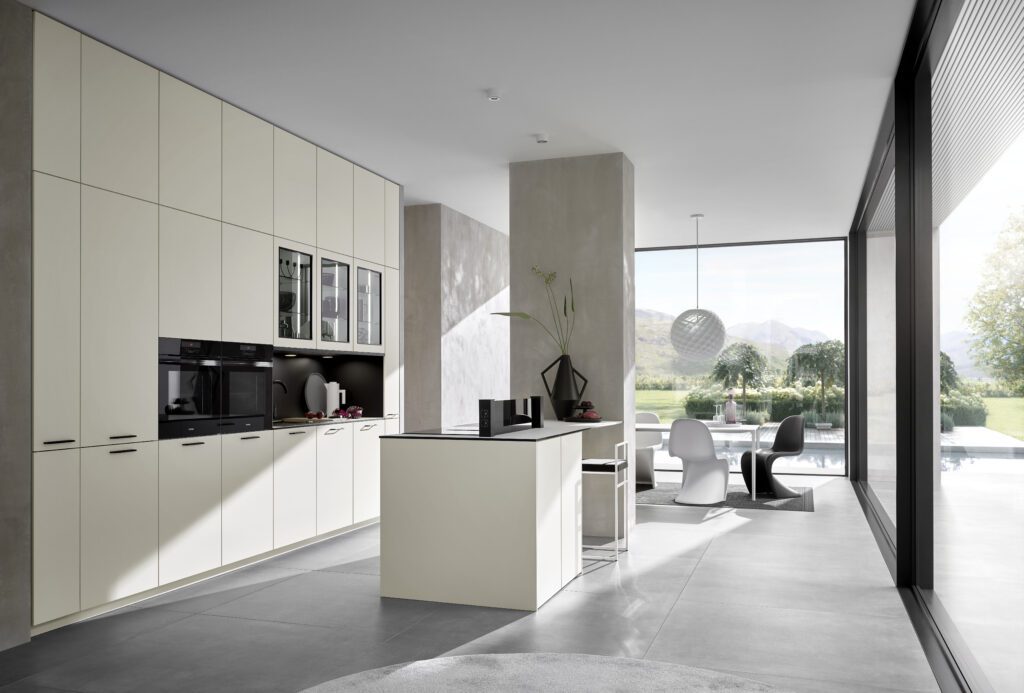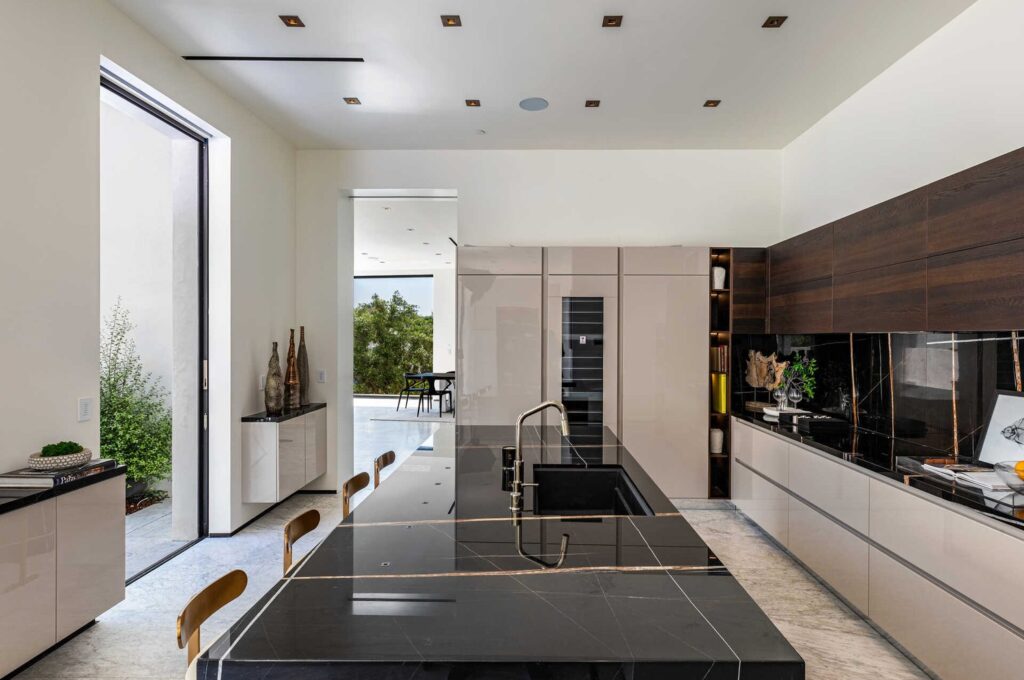Walk into any kitchen showroom and you'll hear the same pitch about “modern kitchen design.”
They'll show you slab doors. Point to frameless construction. Maybe mention some trendy hardware or countertop material.
Then they'll try to cram these elements into your space as quickly as possible to hit their monthly sales quota.
This isn't modern kitchen design. This is modern kitchen sales.
True modern kitchen design follows the Bauhaus principle established over a century ago: Form follows function. The way your kitchen looks should be determined by how you live, not by what's easiest to sell.
In this post, you'll discover:
- The Bauhaus Foundation of Modern Kitchen Design
- Sales-Driven Design vs. Identity-Driven Design
- Why Most “Modern” Kitchens Fail Their Owners
- The Real Modern Kitchen Design Process
- Questions Real Designers Ask (That Salespeople Don't)
- How Identity-Driven Design Actually Works
- The German Approach to Modern Kitchen Design
- What to Expect from True Modern Kitchen Design
- Why This Process Takes Time (And Why That's Good)
- Recognizing Real Modern Kitchen Design
The Bauhaus Foundation of Modern Kitchen Design
In 1919, the Bauhaus school revolutionized design with a simple principle: Form follows function.
This means the appearance of something should be determined by its purpose, not by aesthetic trends or sales convenience.
Applied to modern kitchen design, this principle demands:
- Understanding how you actually use your space
- Designing storage around your specific belongings and habits
- Creating workflows that eliminate wasted motion
- Integrating technology to serve your lifestyle
- Choosing materials based on performance, not just appearance
The Bauhaus principle asks: What does this person need their kitchen to do, and what form best serves that function?
Sales-driven design asks: What can we sell them quickly that looks modern enough?
The results are completely different.
Sales-Driven Design vs. Identity-Driven Design
Most kitchen companies operate on sales quotas, not design principles.
Sales-driven modern kitchen design:
- Starts with available cabinet styles and tries to fit them into your space
- Focuses on closing deals quickly with minimal customization
- Uses generic storage solutions that work “well enough” for most people
- Prioritizes profit margins over optimal functionality
- Measures success by units sold, not client satisfaction
Identity-driven modern kitchen design:
- Starts with understanding your lifestyle and builds around it
- Takes time to analyze your specific needs and behaviors
- Creates custom solutions for your unique requirements
- Prioritizes long-term functionality over short-term profits
- Measures success by how well the kitchen serves your daily life
The difference is profound. One approach treats you like a transaction. The other treats your kitchen like a custom solution.
Why Most “Modern” Kitchens Fail Their Owners
Here's what happens when modern kitchen design is driven by sales quotas instead of Bauhaus principles:
Generic Solutions for Unique Lives Standard cabinet configurations that don't match how you actually store and use items. You adapt to the kitchen's limitations instead of the kitchen adapting to your needs.
Aesthetic Over Function Slab doors and handleless cabinets that look modern but create daily frustrations. Beautiful photos, frustrating reality.
Rushed Planning Designers who spend more time on pricing than on understanding your lifestyle. Critical functional details get overlooked in the rush to close deals.
Component Assembly Cabinets, countertops, and appliances sourced from different suppliers and assembled on-site. No systematic integration or unified design thinking.
One-Size-Fits-All Mentality Storage solutions and layouts based on industry standards, not your specific requirements. Your unique needs get ignored for manufacturing convenience.
The Real Modern Kitchen Design Process
True modern kitchen design begins with a fundamental question: How do you live?
Phase 1: Lifestyle Analysis Real designers spend significant time understanding your daily routines, cooking habits, storage needs, and long-term goals. They observe how you move through your current space and identify pain points you might not even realize you have.
Phase 2: Behavioral Mapping They analyze your specific workflows – how you prep, cook, clean, and store. Where do you naturally want to place items? What tasks take longer than they should? How do multiple people use the space simultaneously?
Phase 3: Identity Integration Your kitchen should reflect who you are, not generic design trends. Do you entertain frequently? Are you serious cooks or quick-meal preparers? Do you have specific dietary needs or cultural cooking requirements?
Phase 4: Custom System Design Only after understanding your identity and behavior do they begin designing the physical space. Every cabinet, every drawer, every surface is planned around your specific needs.
Phase 5: Integrated Engineering True modern kitchen design integrates all elements – cabinets, countertops, appliances, lighting, and technology – as a unified system, not separate components.

Questions Real Designers Ask (That Salespeople Don't)
When you work with someone who truly understands modern kitchen design, you'll be amazed by the questions they ask.
About Your Daily Reality:
- Walk me through your typical morning routine in the kitchen
- What's the most frustrating thing about your current kitchen?
- How do you naturally move when you're cooking?
- What items do you use daily vs. occasionally?
- How has your cooking evolved over the past five years?
About Your Lifestyle:
- How do you entertain, and how often?
- Who else uses the kitchen, and how?
- What are your long-term goals for this space?
- How do you prefer to organize and store things?
- What technology do you want integrated?
About Your Identity:
- What does “home” mean to you?
- How do you want to feel in this space?
- What activities happen in your kitchen beyond cooking?
- How important is sustainability to you?
- What's your relationship with cooking and food?
Most people say: “No one has ever asked me these kinds of questions before.”
That's because most kitchen companies are focused on selling products, not designing solutions.
How Identity-Driven Design Actually Works
Real modern kitchen design is a collaborative process that unfolds over time.
Discovery Phase Extensive conversations about your lifestyle, habits, and goals. Site visits to observe how you actually use your current space. Analysis of your belongings, storage needs, and workflow patterns.
Conceptual Design Initial space planning based on your specific requirements, not standard layouts. Custom storage solutions designed around your actual items. Workflow optimization to eliminate wasted motion and effort.
System Integration Coordination of all elements – cabinets, countertops, appliances, lighting, and technology – as a unified system. Engineering solutions that serve your specific needs rather than generic requirements.
Refinement Process Multiple iterations based on your feedback and lifestyle changes. Detailed planning of every drawer interior, every storage solution, every functional element.
The result? A kitchen that feels like it was designed specifically for you. Because it was.
The German Approach to Modern Kitchen Design
German manufacturers have been perfecting identity-driven modern kitchen design for over a century.
German Design Philosophy:
- Function determines form, always
- Precision engineering serves daily life
- Quality materials support long-term use
- Systematic thinking integrates all elements
- Customization serves individual needs
German Design Process:
- Extensive lifestyle analysis before any design work begins
- Custom manufacturing based on specific requirements
- Integration of all systems during manufacturing, not assembly
- Rigorous quality control throughout the process
- Lifetime support for the complete system
The German approach treats modern kitchen design as engineering, not decoration.
What to Expect from True Modern Kitchen Design
When you work with someone who truly understands modern kitchen design principles, the experience is completely different.
Comprehensive Discovery Expect to spend significant time discussing your lifestyle, habits, and goals. Real designers need to understand how you live before they can design how you'll live better.
Custom Solutions Every element will be designed specifically for your needs. Storage solutions for your actual belongings. Workflows optimized for your cooking style. Technology integrated to serve your preferences.
Systematic Integration All elements – cabinets, countertops, appliances, lighting – will be planned as a unified system. No retrofitting or compromise solutions.
Quality Focus Materials and construction methods chosen for long-term performance, not just initial appearance. Investment in solutions that improve your daily life for decades.
Ongoing Relationship True designers maintain relationships with clients long after installation. They understand that great design evolves with your changing needs.
Why This Process Takes Time (And Why That's Good)
Real modern kitchen design can't be rushed.
Understanding your identity and behavior takes time. Quick consultations and fast quotes miss the nuances that make the difference between a good kitchen and a perfect one.
Custom solutions require engineering time. Off-the-shelf products can be sold quickly. Custom systems designed around your specific needs require careful planning and precision manufacturing.
Quality integration demands coordination. When all elements are engineered as a unified system, every detail must be planned and coordinated before manufacturing begins.
The timeline typically spans 4-8 months from initial consultation to final installation. This includes discovery, design, engineering, manufacturing, and installation.
Companies that promise faster timelines are selling products, not designing solutions.

Recognizing Real Modern Kitchen Design
Here's how to identify professionals who truly understand modern kitchen design:
They Ask More Questions Than They Answer Real designers spend more time learning about you than talking about their products. They're genuinely curious about how you live and what you need.
They Focus on Function Before Form Aesthetic discussions come after functional requirements are established. They want to understand how you work before they show you how it will look.
They Offer Custom Solutions Everything is tailored to your specific needs. Generic solutions and standard configurations are starting points, not final answers.
They Think Systematically They discuss cabinets, countertops, appliances, and technology as integrated elements, not separate purchases.
They Plan for the Long Term They ask about your future needs and goals. They're designing for how you'll live for decades, not just today.
They Take Time They don't rush the process. Real design thinking requires time to understand, analyze, and create optimal solutions.
The Investment in Real Modern Kitchen Design
True modern kitchen design requires investment in both time and resources.
Professional design services for comprehensive lifestyle analysis, custom space planning, and system integration typically range from $5,000-15,000. (We're currently offering this process to qualified projects as a complimentary service… you can apply here)
Custom German kitchen systems engineered around your specific requirements start at $50,000 and can reach $150,000+ for fully-integrated solutions.
The value proposition is clear: Instead of adapting to your kitchen's limitations for decades, you invest once in a system that adapts to your life.
Most clients say: “This is completely different from working with other kitchen companies.”
Because it is. Real modern kitchen design prioritizes your long-term satisfaction over short-term sales quotas.
Your kitchen should serve your identity and behavior, not force you to adapt to generic solutions.
That's what modern really means.
If you'd like help creating a modern kitchen that is designed around you, not sales quotas… then sign up for our complimentary design offer here.
